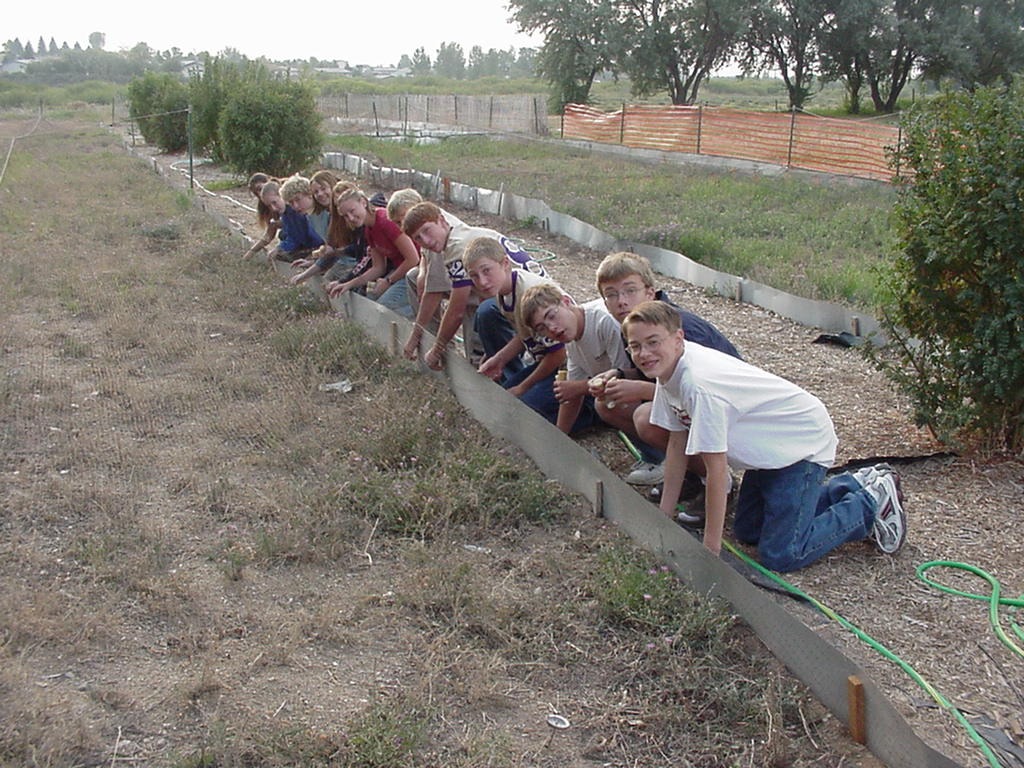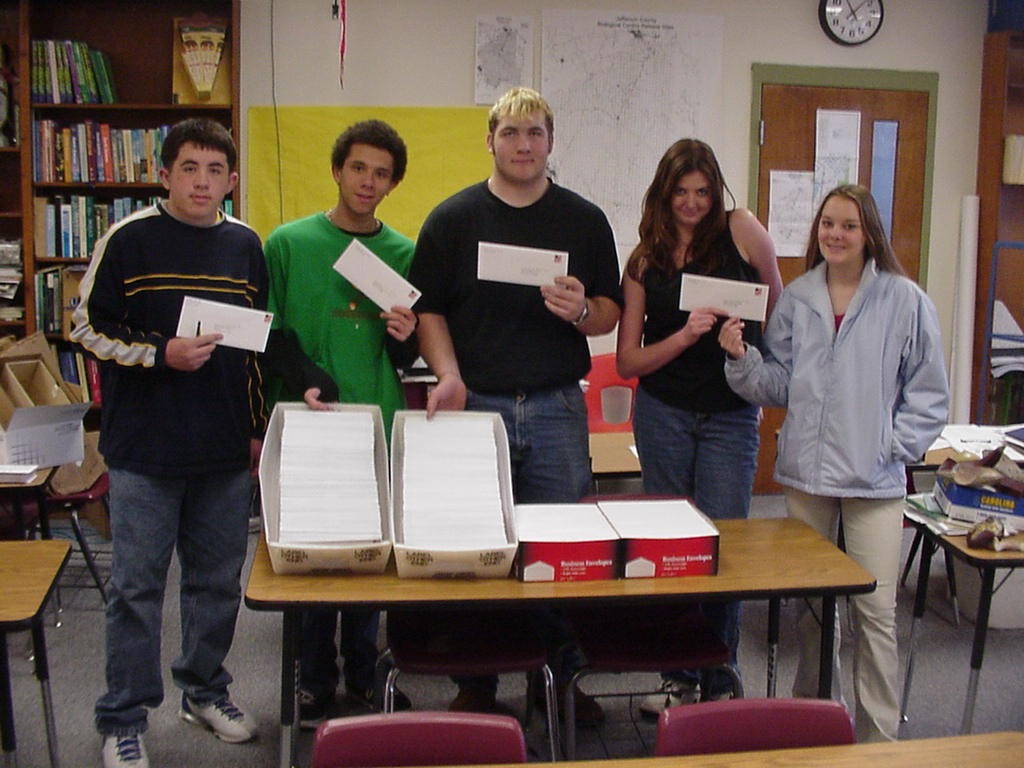Whitehall Noxious Weed Control Project
Bioagents Collection Numbers
Knapweed Insectary at the Ag. Experiment Station in Corvallis, MT
The Whitehall Project involves using classical biological control of noxious weeds. Two teachers and 3 students in Whitehall, Montana dedicate their summer to this project in both Madison and Jefferson Counties. The project involves: 1) mass rearing of two spotted knapweed root borers on the Whitehall High School grounds [Cyphocleonus achates and Agapeta zoegana], 2) monitoring over 500+ biorelease sites with over 120 land owners, 3) collection, augmentation and redistribution of bioagents, 4) locating, mapping and photographing biorelease sites, 5) fostering cooperative weed control relationships, 6) helping other similar project (at schools or other locations) start up and continue, and 7) educating others about the noxious weed problem and its solutions.
Whitehall Project student Nelson Godbolt showing Nancy Schweitzer (Montana's First Lady, her husband is our Governor) how the Cyphocleonus weevils damage the roots of spotted knapweed, summer 2006. Photo by Whitehall Project student Michaela Olson while we were touring the Victor and Darby knapweed insectaries. We all also collected and Nancy released weevils along HW 93 near Victor, MT.
The project started in the early 1990's with teacher Mr. Breitenfeldt's interest in biological weed control insects. He began to incorporate noxious weeds into his curriculum and with students, to participate in local weed control efforts. With the help of the then Jefferson Co. Weed Supervisor Pat Kountz and following Weed Coordinators Dave Burch, Kim Johnson, Jay Cole and Sam Little, Mr. B and his students became more and more involved in weed control efforts. This then developed into a summer program funded in part by the Montana Noxious Weed Trust Fund and various agencies, local land owners and industries. The project was affiliated with Jefferson County for a decade, then 2 years with Madison County, and is now a not for profit called The Whitehall Biological Weed Control Project, Inc..
In 2004, teachers Mr. Dan Jones, Harrison and Ms. Mellissa Newman, Ennis and students were hired from both Harrison Schools and Ennis Schools in Madison County. The project was than called the WHE Project (Whitehall, Harrison, and Ennis Project). Insectaries were created at Harrison and Ennis schools and these teachers and students were trained all about how to replicate the Whitehall Project in their area. As of 2006 and as per our long range planning, Ennis and Harrison are now (2006) on their own though we still cooperate quite closely in insect collections and distribution.
In 2004 we also started to teach a summer class (Whitehall, 2006 and Boise, ID) for teachers and others, all about how to replicate all the weed control strategies we do here in the Whitehall area. We have helped many teachers start similar programs in their areas. For a list of these schools/programs see the home page (http://mtwow.org/) and look under the heading: Other School Insectaries & Projects.
It is the goal of this project to have a knapweed insectary and noxious weed education associated with a school in every county in Montana and in every State in the West!
Goals for 2005
Mission Statement:
"To have a noxious weed/invasive species educational program in every school in Montana and to have these issues addressed in the Montana State Content Standards (K-12).""To have a knapweed insectary with a noxious weed educational program in every Montana County and Western State with a significant knapweed infestation."
"To have programs in every Montana County that can find and utilize "bursts" of biocontrol agents as they occur, preferably involving local students and teachers."
"To continue the Whitehall Project as a demonstration project and to provide continuing weed control benefits (bioagents and education) to the local area and to cooperators."
Whitehall Project
Summary (03)
Whitehall Project Accomplishments (03)
Project Objectives For '03
How The Project Will Be Carried Out (03)
Whitehall Project Benefits
Other General Information
Noxious Weed Trust Fund Grant: [2003 Text] [2004 Text] [2005 Text] [2006 Text]Educational Efforts:

Students collecting knapweed root boring weevils along the edges of the knapweed insectaries. Sept., 2003. Photo by T. Breitenfeldt.
Summer Class Outline - The Whitehall Project, A Replaceable Weed Fighting Strategy. A 3-day +2-day optional class offered at no cost in Whitehall, MT on July 10-14th, 2006. Ten teachers will receive mileage, hotel and meal costs. In addition this year we have an optional 2-day extension (again, 10 paid slots for this) to the Grassrange area to collect leafy spurge flea beetles (we collected 1,500,000 last summer in two partial days!). Suggested audience: a team consisting of one Teacher and one Weed Professional as mentor. However, any individuals and high school students are welcome! Email Mr. Breitenfeldt: tbreit@whitehallmt.org for more information, preregistration required as space is limited. You may take the class for teacher recertification credits or for 1 college credit: Bio 491, U of M Western Out Reach, 1-866-799-9140.
Also a class in Boise, ID June 27-29th. See: http://mtwow.org/Boise_Summer_Class_Bugs_With_An_Attitude.html
Net (Collection) Days
Teacher Conventions ['02]
Teacher Noxious Weed Curriculum
Whitehall Ledger "Weed Whackers" Summer Articles

Students with the over 1,200 letters sent out for: 1) the summer class, 2) noxious weed curriculum, and 3) the Montana Weed Control Association. Letters were mailed to every Montana School Superintendent and Science teacher plus, all the weed fighters listed in the 2004 Montana Weed Calendar. 4/2/04. Photo by T. Breitenfeldt.
Knapweed Insectary -mass rearing two knapweed biocontrol agents.
How To Make A Knapweed Insectary
Other Insectaries/Programs:
Augusta
Townsend
Warm Springs
Harrison
Ennis
Eureka
Noxon
Troy
Superior
Darby
Victor
Missoula - Target Range
Missoula - Hellgate Middle School
Bonner
Clancy
Colstrip
Stanford
Fairfield, ID
Priest River, ID
Biocontrol Agent Collection, and Redistribution Efforts
2004 Bioagents Collection Numbers
Aphthona sp. (flea beetles) -leafy spurge root feeding beetles (6 species). [2003]
Agapeta zoegana -knapweed root boring moth. [2003]
Calophasia lunula -toadflax defoliator. [2003]
Cyphocleonus achates -knapweed root boring weevil. [2001] [2002] [2003]
Larinus minutus -knapweed seed head weevil. [2003]
Mecinus janthinus -toadflax stem boring weevil. [2003]
Oberea erythrocephala -leafy spurge root boring beetle. [2003]
Sphenoptera jugoslavica -knapweed root boring beetle. [2003]
Net (Collection) DaysBiocontrol Release Site Monitoring [knapweed]
Landowner Education [ FAQ's ]
Fostering Cooperation
Successful Release Sites [1]Biocontrol Release Site Mapping
How-To
Maps
mtwow.org HOME